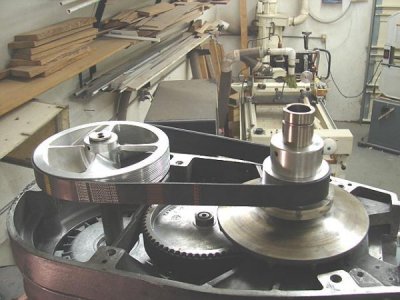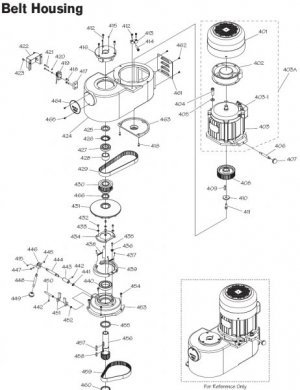-
Welcome back Guest! Did you know you can mentor other members here at H-M? If not, please check out our Relaunch of Hobby Machinist Mentoring Program!
You are using an out of date browser. It may not display this or other websites correctly.
You should upgrade or use an alternative browser.
You should upgrade or use an alternative browser.
Need Opinions On Belt Drive
- Thread starter JimDawson
- Start date
- Joined
- Sep 28, 2013
- Messages
- 4,318
Well I intended to put them on the list, but I used the wrong name.I just can't see the need for the extra expense, and I just don't have time to make them. I'm already working 7 days a week trying to keep up. Pesky customers are keeping me from the projects I would like to be doing.
I would just like to get the yard (jungle) mowed!
that's fair enough, just wanted to get the idea back out there.
- Joined
- Oct 3, 2015
- Messages
- 985
I used a J12 poly vee, and it has much more gripping power and flexibility than a standard v belt. Spindle wind up time has been decreased by 80%. I made a 7" pulley for the motor, and a 3" for the spindle. @90 Hz it will spin at 6200 rpm, although I never run it over 5500. The poly vee belts are cheap, and will last forever, but you will have to make the pulleys. I milled fan blade spokes into the motor pulley to help with cooling and it works so good that I probably didn't need the auxiliary fan.
I milled fan blade spokes into the motor pulley to help with cooling and it works so good that I probably didn't need the auxiliary fan.
I'm going to do the same conversion on my manual mill, but I think I'm going 2:1 ratio instead of 2.33:1.
 I milled fan blade spokes into the motor pulley to help with cooling and it works so good that I probably didn't need the auxiliary fan.
I milled fan blade spokes into the motor pulley to help with cooling and it works so good that I probably didn't need the auxiliary fan. I'm going to do the same conversion on my manual mill, but I think I'm going 2:1 ratio instead of 2.33:1.
- Joined
- Feb 8, 2014
- Messages
- 11,144
With a cogged or poly V belt you could use aluminum pulleys that decrease the rotational mass.
In thinking about that a bit, it seems to me that in this case having more mass, the flywheel effect, would help the machine run smoother. Especially when using a large face mill on a narrow part or something like that where you could have a pretty dramatic interrupted cut. I'm guessing the original drive pulley system probably weighs at least 20 lbs combined. I am actually thinking about leaving as much of the original of the rotating mass in place as possible. With the veri-drive pulleys opened all the way up, there is a gap of about 1.5 inches between the halves. I might be able to just squeeze a new sheave in that space, if it lines up correctly.
- Joined
- Jun 12, 2014
- Messages
- 4,819
You have more of a balance issue with heavy pulleys with a lot of rotating mass and this will be exacerbated at speed. You should not need the heavy flywheel affect if you are running sensorless vector on a good VFD, you should be able to maintain around +/-1 RPM under varying load. On the lathe systems I have done, which has a lot more rotational mass and load with deeper cuts, on a 3 Hp inverter motor system there is essentially no RPM change with cutting load. If your seeing that, then you could have an issue sizing the motor or pulley ratios correctly. Compared to tradition V belts, the poly V and cogged belts run so much more smoothly with almost no belt vibration.
One other factor is that running your inverter motor to 120 Hz (and higher) will give you full Hp from 60-120 HZ, compared to a stock 60 Hz motor which needs to be pulleyed up to speed, you cut the Hp by 50% when you belt up to the same speed as opposed to running a motor at 120 Hz, the torque is the same when you factor the doubling of the pulley ratio needed for a 60Hz motor. I use a 2 Hp Baldor Inverter/Vector motor to 120 Hz on my lathe, it is rock solid to within +/- 1 RPM on the spindle speed to 1800 RPM. The motor is rated to 600o RPM for full Hp. The inverter motors with a sensorless vector VFD hold suprisingly tight RPM control, on one install we looked at using the attached motor encoder, but it would have not improved the speed control we where achieving. One other factor is that with Invertor motors you can push the overload point to around 180%, which they can usually sustain for ~1 minute, this can pump a lot of added motor control power for short periods.
I was looking at the use of cogged belts for various drive systems a couple of years ago, there was a ton of factory pulleys that could be bored or sheaved to the shaft size. The outfit carried all types of pulleys and drives, I need to dig through to find the link. There also may be some issues with the maximum speed ratings of standard V belts and pulleys, since the motor end will be running up to 4500 RPM. The maximum rim speed for iron pulleys is 6500 FPM, this is exceeded significantly if you are using a 6.75" pulley at this RPM, at least by my calculations.
Belt drive system on Grizzly VFD mill heads, not much rotational mass and small pulleys, maximum speed is 5000 RPM.

One other factor is that running your inverter motor to 120 Hz (and higher) will give you full Hp from 60-120 HZ, compared to a stock 60 Hz motor which needs to be pulleyed up to speed, you cut the Hp by 50% when you belt up to the same speed as opposed to running a motor at 120 Hz, the torque is the same when you factor the doubling of the pulley ratio needed for a 60Hz motor. I use a 2 Hp Baldor Inverter/Vector motor to 120 Hz on my lathe, it is rock solid to within +/- 1 RPM on the spindle speed to 1800 RPM. The motor is rated to 600o RPM for full Hp. The inverter motors with a sensorless vector VFD hold suprisingly tight RPM control, on one install we looked at using the attached motor encoder, but it would have not improved the speed control we where achieving. One other factor is that with Invertor motors you can push the overload point to around 180%, which they can usually sustain for ~1 minute, this can pump a lot of added motor control power for short periods.
I was looking at the use of cogged belts for various drive systems a couple of years ago, there was a ton of factory pulleys that could be bored or sheaved to the shaft size. The outfit carried all types of pulleys and drives, I need to dig through to find the link. There also may be some issues with the maximum speed ratings of standard V belts and pulleys, since the motor end will be running up to 4500 RPM. The maximum rim speed for iron pulleys is 6500 FPM, this is exceeded significantly if you are using a 6.75" pulley at this RPM, at least by my calculations.
Belt drive system on Grizzly VFD mill heads, not much rotational mass and small pulleys, maximum speed is 5000 RPM.

- Joined
- Feb 8, 2014
- Messages
- 11,144
The maximum rim speed for iron pulleys is 6500 FPM, this is exceeded significantly if you are using a 6.75" pulley at this RPM, at least by my calculations.
That is correct by my calculations also, I'm cutting down to about 5 inch pulleys.
Still thinking about the ratio, 1:1 seems correct, but I need to think this through. Most of my work is done with 1/2 inch and smaller end mills, so the torque requirement is minimal. If I need more torque, there is always back gear at about 8:1 reduction. That would give me about 560 RPM at the spindle with the motor turning 4500 RPM.
Mechanical parts cost is $129 for a single groove 3VX belt system, $292 for a 10 groove Poly-V belt system, $164 difference. Worth it to me if there is a significant improvement in performance.
- Joined
- Feb 2, 2013
- Messages
- 3,628
Hi Jim
great project!
i was wondering if you tried to source the drive components through industrial surplus vendors on EBAY?
you'd be surprised how much you can get for a small amount of searching
i use a lot of gates polyflex 2v belts for 3 hp service
they grip very well, last forever and don't stretch
the belt sheaves are easy and fun to make
great project!
i was wondering if you tried to source the drive components through industrial surplus vendors on EBAY?
you'd be surprised how much you can get for a small amount of searching
i use a lot of gates polyflex 2v belts for 3 hp service
they grip very well, last forever and don't stretch
the belt sheaves are easy and fun to make
- Joined
- Jun 12, 2014
- Messages
- 4,819
I would also check out this site, wide range and would seem less expensive. Torque should be about the same as the current configuration above your base speed, if lower speed is needed, even with a back gear it should be good for below 1000 RPM, and torque is flat down to 0 RPM on these motors.
SDP/SI
http://www.sdp-si.com/
http://www.sdp-si.com/products/Timing-Belt-Pulleys/
SDP/SI
http://www.sdp-si.com/
http://www.sdp-si.com/products/Timing-Belt-Pulleys/
- Joined
- Feb 8, 2014
- Messages
- 11,144
i was wondering if you tried to source the drive components through industrial surplus vendors on EBAY?
you'd be surprised how much you can get for a small amount of searching
That was very worthwhile search!

I found these guys; https://www.ametric.com/default.aspx
Large inventory and good prices. Going to add them to my preferred vendor list.

